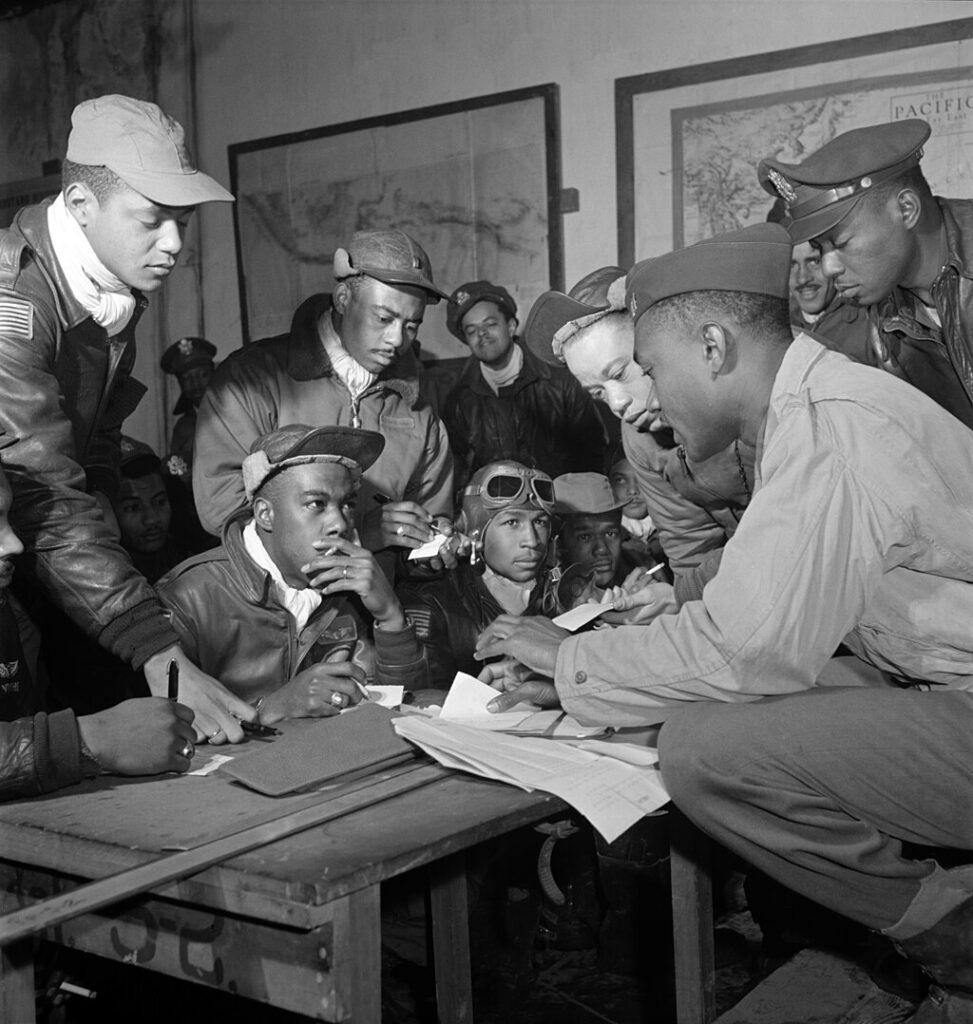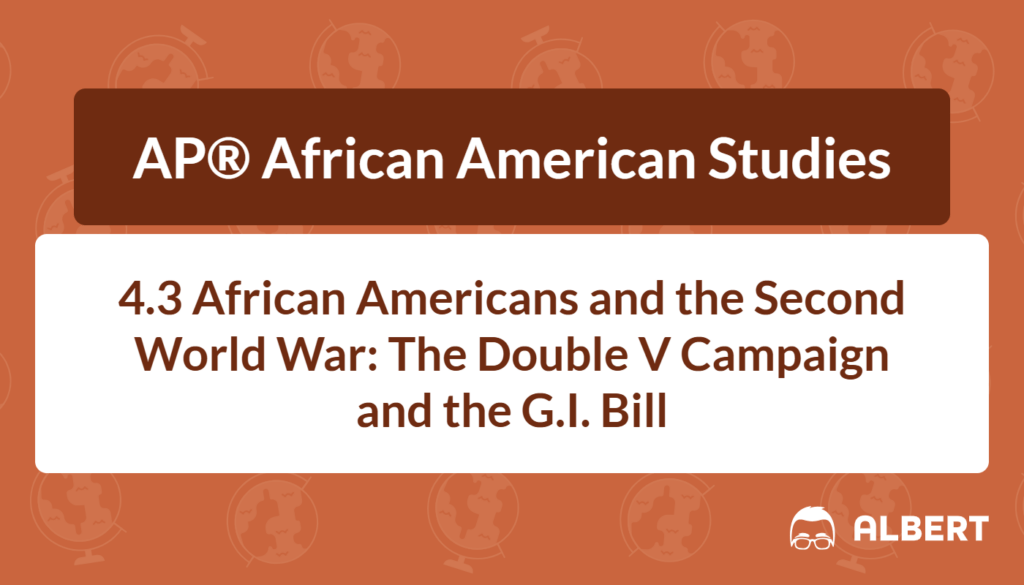What We Review
African Americans and the Second World War: The Double V Campaign and the G.I. Bill
During the Second World War, African Americans in WWII served their country while also fighting for their own civil rights. Their involvement in this global conflict marked a turning point in the quest for equality. Understanding the roles African Americans played during World War II, as well as the impact of the Double V Campaign and the G.I. Bill, reveals important themes in African American history. This post explores those contributions and highlights the challenges and triumphs of these individuals during a critical time in the United States.
Introduction
African Americans in WWII faced both external battles against fascism and internal struggles against segregation. More than two million African Americans either volunteered or registered for the draft, joining every branch of the U.S. Armed Forces. Their commitment demonstrates the alignment of patriotic duty with a fight for civil rights. This post begins by examining African American military service and moves on to discuss the Tuskegee Airmen, the Double V Campaign, and the G.I. Bill. Understanding these topics helps illustrate the progress, setbacks, and legacy of African Americans’ involvement in World War II.
African Americans in World War II
Overview of African American Military Service
At the war’s start, the United States Armed Forces remained segregated. African Americans were placed in separate units, trained in separate facilities, and sometimes commanded by white officers. Despite these conditions, over two million African Americans heeded the nation’s call to arms.
• These brave individuals filled a wide range of roles:
- Infantry soldiers in Europe and the Pacific.
- Support staff in supply, logistics, and medical units.
- Technicians and mechanics critical to maintaining equipment.
However, African American troops often faced discrimination from fellow Americans, leading many to question the contradictory nature of fighting for freedom abroad while being denied full rights at home. Therefore, they adopted a dual mission: securing victory against Axis powers and advancing racial equality in the United States.
Example: Enlistment
A common path for African Americans was through the draft registration process. This step-by-step approach began with completing official paperwork at local draft boards. Next, potential recruits underwent physical examinations to determine eligibility. After being called to serve, many joined segregated units or training camps. Despite these obstacles, African Americans served with distinction, hoping their service would help elevate the call for equal treatment.
The Tuskegee Airmen
Who Were the Tuskegee Airmen?

Among the most famous groups of African American servicemen were the Tuskegee Airmen. These brave pilots were the first African American military pilots in the United States Army Air Corps. Their training began at Tuskegee Institute (now Tuskegee University) in Alabama.
- Rigorous training prepared these pilots for aerial combat.
- They faced both the challenge of flying dangerous missions and overcoming deep-seated racism.
- Their efforts helped pave the way for the future integration of U.S. military forces.
The Tuskegee Airmen’s success proved African American men could excel as combat pilots and leaders in the armed forces. Their bravery inspired many at home, demonstrating the potential for African Americans to thrive when given equal opportunities.
Example: The Battle of Anzio
During the Battle of Anzio in Italy, the Tuskegee Airmen played a key role by escorting bombers across heavily defended areas. They deftly protected Allied planes from enemy fire and supported ground troops, ensuring vital operations continued. Their performance involved:
- Planning each flight path and identifying potential threats.
- Coordinating with Allied bombers to maintain formation.
- Engaging enemy aircraft to secure the skies.
These missions helped shape Allied successes in Europe and further highlighted the Tuskegee Airmen’s competence and courage.
The Double V Campaign
Origins of the Double V Campaign
While serving overseas, African Americans noticed the irony of combating fascist regimes abroad when segregation still limited their freedoms at home. This realization sparked the Double V Campaign, which stood for “double victory”: victory against fascism overseas and victory against racial injustice in the United States.
- The campaign grew from the feeling that one battle could not be won without the other.
- Many African Americans believed national unity required ending Jim Crow laws and ensuring equal rights.
- Newspapers, community leaders, and civil rights organizations promoted the Double V symbol as a show of solidarity.
James G. Thompson’s Letter and Its Impact
In 1942, James G. Thompson wrote a letter to the Pittsburgh Courier newspaper. By asking whether he should “sacrifice to live half-American,” he sparked a national conversation about the moral contradictions of the war effort. Thompson’s letter suggested that true national unity required an end to discrimination.
His words resonated with readers who saw a clear connection between fighting tyranny abroad and confronting it at home. African Americans increasingly made their voices heard, pushing for legislation and social change.
Example: Community Actions
Across the nation, African American communities organized protests and rallies to spread awareness. They also supported local initiatives:
- Setting up Double V clubs where people could discuss strategies for ending segregation.
- Raising funds for legal efforts to challenge discriminatory state laws.
- Encouraging voter registration drives to reshape political representation.
These actions demonstrated a strong commitment to the campaign and laid the foundations for broader civil rights efforts in the decades that followed.
The G.I. Bill and Its Impact
Overview of the G.I. Bill (1944)
Toward the end of World War II, Congress passed the G.I. Bill, officially known as the Servicemen’s Readjustment Act of 1944. This law aimed to assist returning veterans by providing:
- Tuition funding for college.
- Low-cost home mortgages.
- Low-interest business startup loans.
More than one million Black veterans qualified for these benefits. However, the Bill’s administration depended on local agencies, which sometimes enforced Jim Crow practices. These discriminatory barriers affected educational, residential, and career opportunities for African American veterans.
Racial Disparities in Access
Under Jim Crow laws, many Black veterans encountered prejudice when attempting to secure loans or educational support. Housing discrimination kept them from buying homes in certain neighborhoods. Furthermore, several academic institutions either refused to enroll Black veterans or limited the number of African American students.
As a result, the potential for economic mobility was uneven. Despite these challenges, the G.I. Bill still opened new doors for numerous Black veterans, enabling some to attend historically Black colleges and universities, start their own businesses, or purchase homes in welcoming communities.
Example: Access to College
Consider a Black veteran returning home in 1945. With G.I. Bill benefits, this individual sought admission to a college that would support veterans of color. In doing so, the veteran might:
- Request guidance from local military advisory boards.
- Seek admission letters from welcoming institutions, such as historically Black colleges.
- Face discrimination from certain schools due to race-based quotas.
Although discrimination persisted, each success story brought renewed hope. Over time, the educational advancements made possible by the G.I. Bill played a role in building a stronger Black middle class and increasing political influence.
Required Sources and Their Historical Context
1. James G. Thompson, “Should I Sacrifice to Live ‘Half-American’?,” Pittsburgh Courier, 1942
- This letter sparked the Double V Campaign. Thompson’s words highlighted the patriotic duty of African Americans and reminded the country that victory abroad should coincide with victory at home.
- His message connected directly to the rising demand for civil rights, shaping public opinion during World War II.
- This photograph depicts African American women serving overseas. The 6888th Battalion, nicknamed the “Six Triple Eight,” was composed entirely of Black women. They organized and distributed mail for millions of American troops.
- The image symbolizes how Black service members, including women, contributed to the war effort while also advocating for respect within segregated units.
3. The Flight Instructor Staff of Tuskegee Army Airfield, Late in the Second World War, 1945
- This photograph shows the first African American flight instructors who trained pilots for combat missions.
- Their work at Tuskegee Army Airfield ensured that new generations of Black flyers were prepared to fight overseas. It demonstrated that African Americans could be both leaders and educators within the military.
Connecting these sources reinforces the key ideas presented in this post. They highlight the dedication of African Americans in both combat and support roles. They also show the fight for equal treatment that ran parallel to the global struggle against fascism. When viewed together, these sources provide a fuller picture of the strengths, contributions, and challenges African American men and women faced during World War II.
Conclusion
The Second World War was a transformative period for African Americans, forcing the nation to confront its ideals of liberty while systemic racism persisted. From segregated military units to vibrant civil rights strategies, African Americans worked diligently to secure freedoms that matched the ideals for which they fought overseas. The Double V Campaign and the G.I. Bill stand out as examples of both progress and adversity. On one hand, they fueled social change and offered new opportunities. On the other, they revealed the discriminatory foundations still deeply rooted in American society.
These wartime events laid groundwork for the larger Civil Rights Movement that emerged in the mid-20th century. Understanding the significance of World War II for African Americans sheds light on the enduring struggle for equality and citizenship. These stories of courage and resilience continue to inspire new generations to question injustice and pursue fair treatment for all.
Quick Reference Chart: Vocabulary
| Term | Definition |
| Segregation | The enforced separation of different racial groups in public and private spaces. |
| Tuskegee Airmen | The first African American military pilots in the United States Army Air Corps. |
| Double V Campaign | A movement advocating for victory against fascism abroad and racial injustice at home. |
| G.I. Bill | A law providing a range of benefits to returning World War II veterans, including Black veterans. |
| Jim Crow Laws | State and local laws that enforced racial segregation in the Southern United States. |
Call to Action
It is helpful for students to continue exploring these pivotal events and figures. Reviewing primary sources like photographs, letters, and newspaper articles provides deeper insight into the day-to-day experiences of African Americans in World War II. Expanding knowledge of African American history fosters a richer understanding of the nation’s past and strengthens analytical skills important for the AP® African American Studies course. Engaging with this history is also a powerful way to appreciate how the legacy of wartime struggles shaped future civil rights movements.
Sharpen Your Skills for AP® African American Studies
Are you preparing for the AP® African American Studies test? We’ve got you covered! Try our review articles designed to help you confidently tackle real-world AP® African American Studies problems. You’ll find everything you need to succeed, from quick tips to detailed strategies. Start exploring now!
Need help preparing for your AP® African American Studies exam?
Albert has hundreds of AP® African American Studies practice questions, free response, and full-length practice tests to try out.









